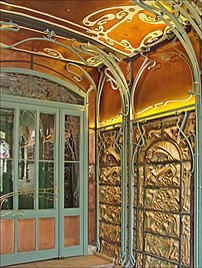Exploring the Elegance of Art Nouveau: A Dive into the Pinnacle of 20th Century Art
- portiaibe
- Nov 17, 2023
- 2 min read
Introduction:
Art Nouveau, a captivating art movement that emerged at the turn of the 20th century, represents a harmonious blend of nature-inspired designs, intricate details, and a departure from traditional artistic norms. This blog will delve into the essence of Art Nouveau, exploring its origins, key characteristics, prominent artists, and lasting influence.
Origins of Art Nouveau:
Art Nouveau, meaning "new art" in French, found its roots in the late 19th century as a reaction to the Industrial Revolution's mass production and the prevailing academic art styles. It sought to infuse creativity and organic forms into various aspects of life, from architecture and furniture to jewelry and visual arts.
Key Characteristics:
1. Nature-inspired Designs: Art Nouveau draws inspiration from the natural world, featuring flowing lines, floral motifs, and depictions of birds and insects. The movement sought to bring the beauty of nature into everyday life.
2. Curvilinear Forms: Embracing sinuous, curving lines, Art Nouveau designs often abandoned rigid, straight lines in favor of graceful, organic shapes. This fluidity added a sense of movement and elegance to artistic expressions.
3. Whiplash Motif: One of the hallmark features of Art Nouveau is the "whiplash" motif, characterized by dynamic, undulating lines resembling the motion of a whip. This motif can be observed in various artworks and architectural details.
Prominent Artists:
1. Alphonse Mucha: Renowned for his iconic posters and illustrations, Mucha's work epitomizes the elegance and decorative nature of Art Nouveau. His intricate designs often feature ethereal female figures surrounded by ornate floral patterns.
2. Hector Guimard: A pioneer in Art Nouveau architecture, Guimard's designs, including the famous Paris Metro entrances, showcase the movement's emphasis on organic forms and innovative use of materials.
3. Louis Comfort Tiffany: Revered for his exquisite stained glass creations, Tiffany's intricate and colorful designs exemplify the fusion of craftsmanship and artistry within the Art Nouveau movement.
Lasting Influence:
While Art Nouveau reached its peak between 1890 and 1910, its influence endures. Many contemporary artists and designers continue to draw inspiration from its organic forms and decorative elements. Additionally, the movement paved the way for subsequent art styles, such as Art Deco, and left an indelible mark on the world of design.
Conclusion:
Art Nouveau remains a captivating chapter in the history of art, marked by its departure from tradition and celebration of natural beauty. From the delicate curves of Mucha's illustrations to the grandeur of Guimard's architectural creations, the movement continues to captivate art enthusiasts and inspire creative minds around the globe. Its legacy serves as a testament to the enduring power of artistic innovation and the timeless allure of nature-inspired design.










Comments